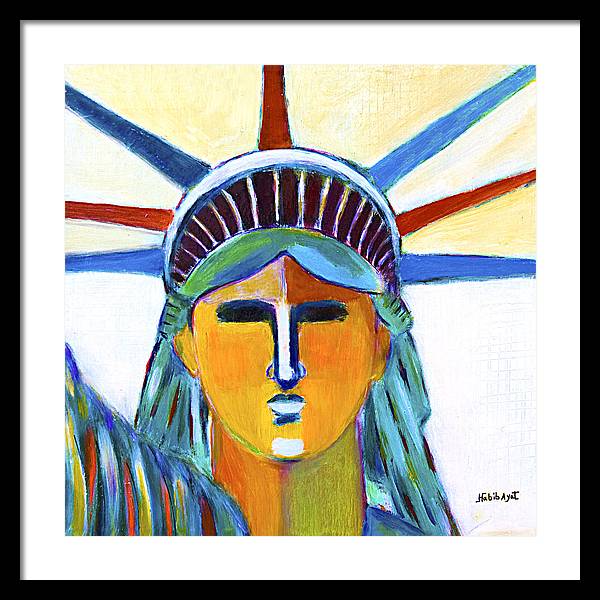THE EVOLUTION OF ABSTRACT ART
Introduction:
Abstract art, a form of art that does not depict recognizable objects, has undergone a significant evolution in the last century. The movement began in the early 20th century with artists breaking away from traditional representational art and has continued to evolve to this day. In this article, we will explore the key movements and artists that have shaped the evolution of abstract art.
Early 20th century:
The term “abstract art” was first used in the early 20th century to describe a new form of art that broke away from traditional representational art. Representational art, also known as figurative art, art that depicts recognizable objects or scenes from the real world. Abstract art, on the other hand, does not depict recognizable objects or scenes, but instead focuses on the use of color, form, line, and texture to create a composition.
One of the earliest and most influential abstract artists of this time was Wassily Kandinsky. Kandinsky was a Russian painter who was one of the pioneers of abstract art. He believed that color and form were the essential elements of art and that they could be used to create a visual language that could express emotions and ideas without the need for representation. His work was a major influence on the development of abstract art, as he was one of the first artists to create completely non-representational paintings.
Kandinsky’s paintings were characterized by their bold use of color and dynamic composition. He believed that color had the power to evoke emotions and that different colors could be used to create different moods. He also believed that the form, shape, and structure of a painting, could be used to create a sense of movement and rhythm. These ideas were groundbreaking at the time and had a significant impact on the development of abstract art.
In addition to his paintings, Kandinsky also wrote extensively about his theories of art and color. His book “Concerning the Spiritual in Art” is considered a classic in the history of art and continues to be widely read and studied today. Through his work, Kandinsky was able to demonstrate that abstract art was a valid and powerful form of expression, and his influence is still felt in the art world today.
Cubism:

Cubism is a movement that emerged in the early 20th century and is considered one of the most important movements in the development of abstract art. It was a key influence on the development of abstract art as it marked a departure from traditional representational art and focused on the formal qualities of art rather than the subject matter.
Cubism was primarily developed by two artists, Pablo Picasso and Georges Braque. They broke down objects into geometric shapes, such as cylinders, spheres, and cones, and rearranged them in abstract compositions. This technique, known as analytical cubism, aimed to depict the subject from multiple viewpoints simultaneously, rather than just one perspective.
The cubist style was characterized by the use of geometric shapes and fragmentation, as well as the use of multiple viewpoints in a single composition. This style of art was a major step towards abstraction, as it focused on the formal qualities of art, such as color, form, and composition, rather than the subject matter. This allowed the artists to create art that was not tied to the representation of the real world but instead focused on the use of color, form, and composition to create a new visual language.
Cubism had a major influence on the development of abstract art, as it marked a departure from traditional representational art and focused on the formal qualities of art. This approach was adopted by many other artists and movements, including Futurism and Suprematism, which also focused on the formal qualities of art rather than the subject matter. This approach to art continues to be an important aspect of abstract art today, with many contemporary artists using the techniques and concepts of cubism in their work.
Futurism:
Futurism was a movement that emerged in Italy in the early 20th century. It was characterized by its focus on the dynamism and movement of modern life, and the artists associated with the movement sought to express this through their art. Futurism was an important influence on the development of abstract art as it marked a departure from traditional representational art and focused on the use of color, form, and movement to create a new visual language.
Leading artists of the Futurist movement include Umberto Boccioni and Gino Severini. They created abstract compositions that conveyed a sense of movement and speed. Boccioni’s painting, “Unique Forms of Continuity in Space” is a famous example of Futurist art that is considered an iconic representation of the movement. The painting depicts a human figure in motion, with its dynamic form and movement expressed through sharp angles and abstract shapes. The work is an excellent example of the Futurist’s efforts to convey movement, energy, and the sense of progress associated with the modern world.
Futurism was not only an art movement but a cultural and social movement that celebrated the technological advancements of the time, they believed in the power of technology to shape the future and improve human life. This belief was reflected in the artworks which celebrated the speed, power, and motion of the new machines that were transforming the world. Futurists also celebrated the dynamism of the urban environment, particularly the new forms of transportation that were making it possible for people to move faster and farther than ever before.
In summary, Futurism was a movement that emerged in Italy in the early 20th century, It focused on the dynamism and movement of modern life, using color, form, and movement to create a new visual language. Artists like Umberto Boccioni and Gino Severini created abstract compositions that conveyed a sense of movement and speed, reflecting the Futurist’s belief in the power of technology to shape the future and improve human life. Futurism was an important influence on the development of abstract art, as it marked a departure from traditional representational art and focused on the use of color, form, and movement to create a new visual language. This approach continues to be an important aspect of abstract art today.
Suprematism:
Suprematism is an art movement that was founded by Kazimir Malevich in Russia in the 1910s. The movement is characterized by its focus on simplicity, geometric shapes, and bold colors. The goal of Suprematism was to create art that was pure and free from any references to the physical world, which is why the artworks created by the movement are considered non-representational.
Malevich, who is considered the founder of Suprematism, believed that art should be free from any references to the physical world and should be based on pure, geometric forms. He believed that these simple forms were the basic building blocks of art and that they could be used to create a new visual language that was not tied to the representation of the real world.
To achieve this goal, Malevich created several compositions were composed of simple geometric shapes, such as squares, circles, rectangles, and bold colors. These shapes were arranged in a way that created a sense of movement and rhythm. The use of simple geometric shapes and bold colors was intended to create a sense of order and harmony, which reflected the artist’s belief that art should be pure and free from any references to the physical world.
The Suprematist movement had a significant impact on the development of abstract art. The use of simple geometric shapes and bold colors was adopted by many other artists and movements, such as the Constructivists in Russia and the De Stijl movement in the Netherlands, which also focused on creating art that was pure and free from any references to the physical world. The influence of Suprematism can still be seen in the art world today, with many contemporary artists using the techniques and concepts of Suprematism in their work.
Abstract Expressionism:

Abstract Expressionism is an art movement that emerged in the United States in the 1940s and 1950s. It is characterized by its focus on the act of painting itself and the use of large-scale canvases to create abstract compositions. Abstract Expressionism is considered one of the most important art movements of the 20th century, and it had a significant impact on the development of abstract art.
The artists associated with Abstract Expressionism were primarily based in New York City and were known for their large-scale canvases, bold brushstrokes, and the use of expressive, gestural techniques. They believed that the act of painting was an important form of self-expression and that the physical process of painting was as important as the final product.
Two of the most important artists of the Abstract Expressionist movement are Jackson Pollock and Mark Rothko. Pollock is considered one of the greatest painters of the 20th century and is known for his drip painting technique. He would drip, pour, and splatter paint on large canvases, creating complex and dynamic compositions. Pollock’s work is considered a masterpiece of the movement, and it continues to be widely admired and studied today.
Mark Rothko, on the other hand, is known for his large, color field paintings. His work is characterized by large fields of color, often with several blocks of color stacked on top of each other. Rothko’s paintings are intended to evoke emotional responses in the viewer, and he believed that art should be a spiritual experience. His work is considered a masterpiece of the movement and continues to be widely admired and studied today.
In conclusion, Abstract Expressionism is an art movement that emerged in the United States in the 1940s and 1950s. It focused on the act of painting itself and the use of large-scale canvases to create abstract compositions. Artists like Jackson Pollock and Mark Rothko were prominent figures of the movement, known for their bold brushstrokes, expressive techniques, and the use of color and form to evoke emotional responses in the viewer. The movement had a significant impact on the development of abstract art and continues to be an important reference in the art world today.
Post-painterly Abstraction:
The Post-painterly Abstraction movement, also known as Color Field painting, emerged in the United States in the 1960s. It is characterized by its focus on the formal qualities of art, such as color, shape, and composition. The artists associated with this movement sought to create abstract compositions that were simple, yet powerful and evocative.
Artists like Ellsworth Kelly and Morris Louis were prominent figures of the movement. Kelly’s work is known for its use of simple shapes and bold colors, often creating geometric compositions. His use of color is considered particularly noteworthy, as he often used a limited palette to create a sense of harmony and balance in his paintings. Kelly’s work is considered a masterpiece of the movement and continues to be widely admired and studied today.
Similarly, Morris Louis is known for his large-scale, color field paintings. His work is characterized by large fields of color, often with several blocks of color stacked on top of each other. Louis’s work is considered a masterpiece of the movement, and his use of color is considered particularly noteworthy. He often used a limited palette to create a sense of harmony and balance in his paintings.
The Post-painterly Abstraction movement is considered an important reference in the art world today, as it represents a new way of creating abstract art that focused on the formal qualities of art. The movement was influential in the development of other art movements such as Minimalism, which also focused on simplicity and reduction. This approach of focusing on the formal qualities of art, such as color, shape, and composition, continues to be an important aspect of abstract art today.
Minimalism:
Minimalism is an art movement that emerged in the United States in the 1960s. It is characterized by its focus on simplicity, reduction, and the use of simple geometric shapes. The artists associated with this movement sought to create art that was stripped down to its essential elements and that focused on the materiality and physicality of the artwork.
Artists like Donald Judd and Carl Andre were prominent figures of the movement. Judd is considered one of the most important Minimalist artists and is known for his sculptures, which often consisted of simple geometric shapes such as boxes or cubes, often made from industrial materials such as steel or aluminum. Judd believed that art should be self-sufficient and that the materials and form of the art should be the focus rather than any symbolic or expressive qualities.
Carl Andre, on the other hand, is known for his sculptures that often took the form of geometric shapes arranged on the floor. His sculptures were often made from industrial materials such as metal plates, bricks, or tiles and were arranged in a grid-like pattern. Andre’s sculptures were intended to be viewed in the round, and he believed that the viewer’s experience of walking around and interacting with the sculpture was an essential part of the artwork.
Minimalism is considered an important reference in the art world today, as it represents a new way of creating art that focused on simplicity, reduction, and the use of simple geometric shapes. The movement was influential in the development of other art movements such as Conceptual Art and Land Art, which also focused on the use of simple geometric shapes and the use of industrial materials. The focus on simplicity, reduction, and the use of simple geometric shapes continues to be an important aspect of abstract art today.
Today:
Today, abstract art is still an active and evolving movement, with new movements and artists emerging all the time. The use of technology and non-traditional materials has become increasingly common in contemporary abstract art, with artists experimenting with new forms of expression and pushing the boundaries of what art can be.
One of the most notable ways in which technology has been incorporated into abstract art is through the use of digital art. Many contemporary artists are using digital tools and software to create abstract compositions, often using algorithms, generative processes, or data visualization to create new forms of art. This has allowed artists to create abstract art that is highly complex, dynamic, and interactive.
Another way in which technology has been incorporated into abstract art is through the use of new materials. Many contemporary abstract artists are using non-traditional materials such as plastic, neon, and LED lights, in their work. These materials allow artists to create new forms of art that are highly interactive, and that change over time.
In conclusion, abstract art continues to evolve and inspire new generations of artists. The use of technology and non-traditional materials has opened up new possibilities for abstract art, and it will be exciting to see where the next phase of abstract art will take us. The evolution of abstract art has been a century-long journey, marked by key movements and artists that have pushed the boundaries of what art can be. From the earliest days of abstraction to the present, abstract art continues to evolve and inspire new generations of artists.
Conclusion:
In conclusion, the evolution of abstract art has been a dynamic and ongoing process that has spanned over a century. The various key movements and artists that have emerged through period have pushed the boundaries of what art can be, and have expanded the possibilities for abstract art. From the earliest days of abstraction, when artists such as Wassily Kandinsky were breaking away from traditional representational art to the present day, where contemporary artists are exploring new forms of expression using technology and non-traditional materials.
The various movements such as Cubism, Futurism, Suprematism, Abstract Expressionism, Post-painterly Abstraction, and Minimalism have each made their own unique contributions to the development of abstract art. These movements have not only expanded the possibilities for abstract art but also provided new ways of creating and thinking about art, which continues to inspire new generations of artists.
As we look to the future, it will be exciting to see where abstract art will take us next. The use of technology and non-traditional materials has opened up new possibilities for abstract artists likely artists will continue to experiment with new forms of expression and push the boundaries of what art can be. The evolution of abstract art is not a finished process, but an ongoing one, and we can look forward to seeing how it will continue to evolve and inspire new generations of artists in the future.






